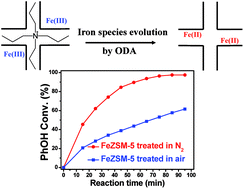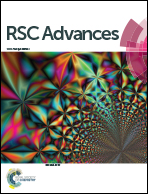Evolution of iron species for promoting the catalytic performance of FeZSM-5 in phenol oxidation†
Abstract
Facile modification of FeZSM-5 utilizing an organic directing agent (ODA) for iron species evolution toward better Fenton activity was developed. Pristine FeZSM-5, prepared hydrothermally using tetrapropylammonium bromide as the ODA, was thermally treated in nitrogen or air atmosphere for comparison. The as-prepared FeZSM-5 were evaluated by XRD, SEM, TGA, Ar physical adsorption, H2-TPR, UV-Vis, XPS and Mössbauer spectra, which confirmed well-dispersed iron species and partial transformation of framework iron to non-framework iron and Fe(III) to Fe(II) during thermal treatment in N2. The phenol oxidation reaction was applied as a probe reaction and phenol conversion can be improved from 44% to 90% within 60 minutes. By thermal treatment in N2 atmosphere, the ODA plays an important role in modifying non-framework iron species from Fe(III) to Fe(II) ions which is desirable for improving catalytic activity in Fenton-like systems. The strategy utilizing the thermal reduction effect of the ODA on iron species is a reliable method for preparing well-dispersed and valence tunable iron oxide nanoparticles encapsulated in ZSM-5.


 Please wait while we load your content...
Please wait while we load your content...